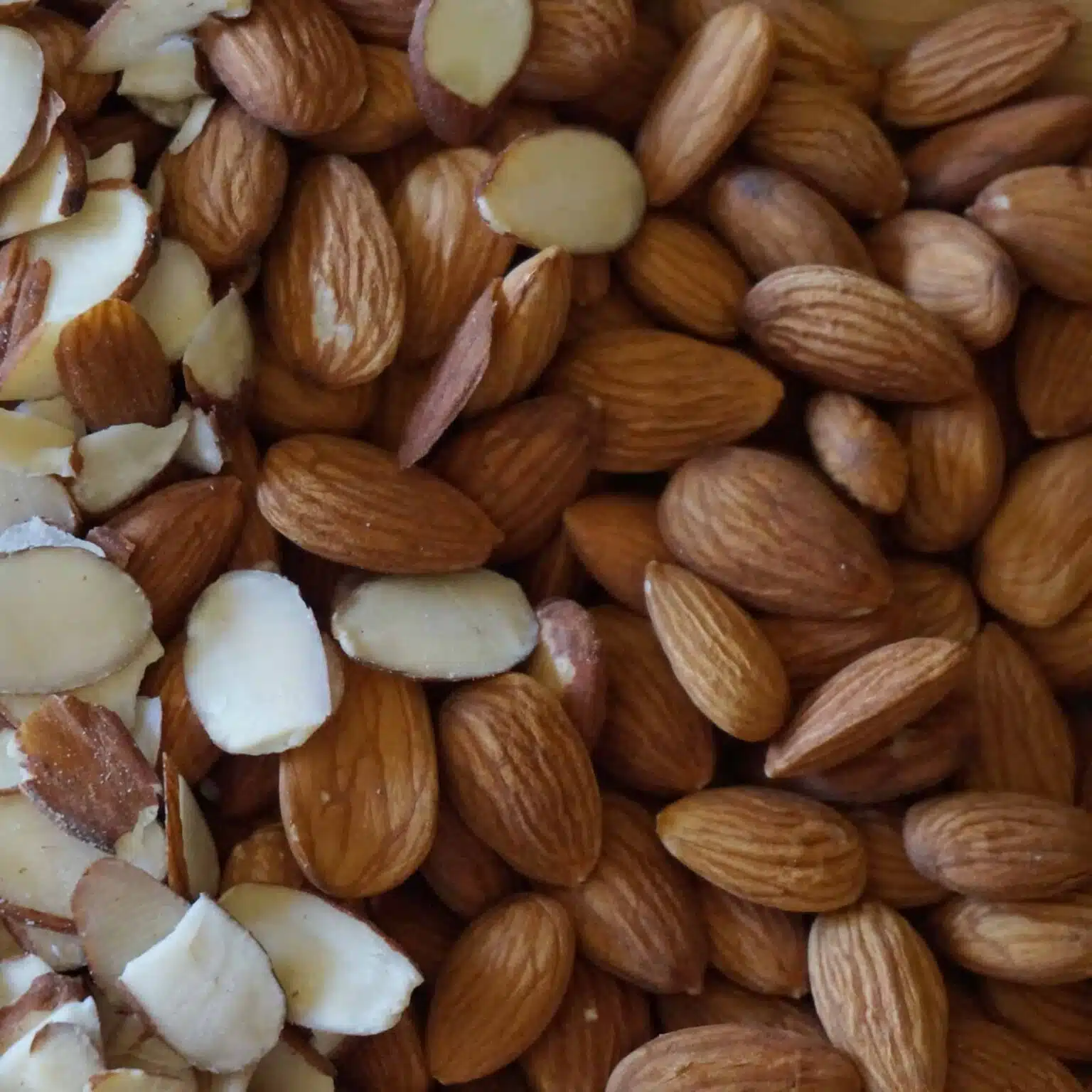According to a randomized controlled trial published in Frontiers in Nutrition, male and female participants who consumed 57g of almonds every day for a month had higher blood levels of the healthy fat 12,13-dihydroxy-9Z-octadecenoic acid (12,13-DiHOME) after a session of vigorous exercise than the control group.
This so-called oxylipin (oxidized fat) molecule, which brown fat tissue produces from linoleic acid, positively impacts metabolic health and energy balance.

Almonds as a four-week dietary supplement
38 men and 26 women between 30 and 65 who didn’t regularly lift weights participated in the clinical experiment. The other half was randomly assigned to the control group, which consumed periodically a calorie-matched cereal bar. About half were assigned to the almond diet group. The researchers collected blood and urine samples before and after the four-week food supplementation period.
A 50-meter shuttle run test, a 30-second Wingate anaerobic test, a vertical leap, a bench press, and leg-back strength drills were all used as performance indicators. Following this 90-minute “eccentric exercise” session, further blood and urine samples were obtained every day for four days.

Exercise recovery among the weekend warrior
The participants completed the “Profile of Mood States” (POMS) questionnaire to score their mental state after each blood draw. They rated their delayed onset muscular soreness on a 10-interval scale, which refers to the discomfort and stiffness experienced after unfamiliar or strenuous activity.
The 90-minute workout raised the volunteers’ self-reported feelings of muscular damage and soreness, as was to be predicted. It also resulted in a rise in their POMS score, which showed increased weariness, anxiety, and depressive symptoms, as well as self-reported decreased vigor.
Pro-inflammatory cytokines, including IL-6, IL-8, IL-10, and MCP-1, temporarily rose in the blood after exercise, which is consistent with mild muscle injury. However, the almond and cereal bar groups saw the same cytokine alterations.

The solution
The 90-minute workout raised the volunteers’ self-reported feelings of muscular damage and soreness, as was to be predicted. It also resulted in a rise in their POMS score, which showed increased weariness, anxiety, and depressive symptoms, as well as self-reported decreased vigor.
Pro-inflammatory cytokines, including IL-6, IL-8, IL-10, and MCP-1, temporarily rose in the blood after exercise, which is consistent with mild muscle injury. However, the almond and cereal bar groups saw the same cytokine alterations.
In particular, following a weekly 90-minute activity, individuals who consumed 57 grams of almonds each day had greater blood levels of a crucial chemical.
Dr. David C. Nieman, the co-author of the study and director of the Appalachian State University Human Performance Laboratory, explains that volunteers who consumed 57g of almonds every day for a month before a single “weekend warrior” exercise session had higher levels of beneficial 12,13-DiHOME in their blood right away after exercising than control volunteers. In comparison to control volunteers, they also stated that they had less weariness and stress, had stronger leg-back strength, and suffered from less muscular injury.

The shorthand for the healthy, oxidized fat is 12,13-DiHOME. 12,13-dihydroxy-9Z-octadecenoic acid, which promotes proper energy and metabolism.
The amount of the chemical was 69 percent greater in people who regularly consumed almonds. The chemical is recognized to assist in repairing common muscle tissue damage caused by exercise.
DiHOME concentration variations in two samples
Notably, the blood plasma concentration of the advantageous 12,13-DiHOME was 69% greater in the almond group individuals than in the control group participants just after exercise. 12,13-DiHOME is known to speed up fatty acid transport and skeletal muscle uptake, promoting metabolic recovery during training.
Another oxylipin, the slightly hazardous 9,10-Dihydroxy-12-octadecenoic acid (9,10-diHOME), which was 40% higher in the blood of the control group following exercise than in the almond group, showed the opposite tendency. 9,10-diHOME, in contrast to 12,13-DiHOME, has been proven to have detrimental impacts on general health and the body’s ability to recover from exercise.
Almond skin polyphenols hold a secret

Nieman and colleagues concluded that eating almonds regularly causes a shift in metabolism, which reduces exercise-induced oxidative stress and inflammation and speeds up the body’s recovery.
They conclude that almonds offer a special and complicated nutritional and polyphenol combination that may aid in metabolic recovery after demanding levels of exercise. Almonds are rich in fiber, healthy fats, vitamin E, minerals, and protein. Additionally, polyphenols found in the brown peel of almonds go to the large intestine where they reduce oxidative stress and inflammation, according to Nieman.













